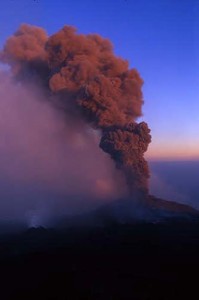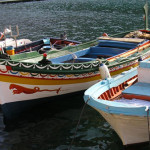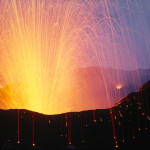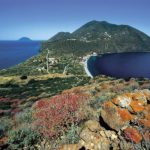
Mount Etna is the highest peak of Sicily (and of Southern Italy) with a height of 3342 meters and it is the Europe’s largest active volcano. From the morphological point of view it is a large mountain that occupies a huge area in the east side of the island. The slopes in the strict sense start at a height of about 1000 meters, drawing a typical shape of truncated cone with slight slopes. At an altitude of 2500 meters slopes become slighter and there are several smaller recent cones. Instead, between 2900 and 3250 meters, slopes become steeper more and more, moving closer to the summit where there are a huge cone and several craters and permanent fumaroles.
The volcanic activity in the Etna area began with a submarine volcanism about 700.000 years ago, gradually moving towards the land, leading to the formation of stratifications of various eruptions (this phenomenon is better known as stratovolcano).
We have historical information of eruptions from more than 2000 years, the last of which occurred in 2001 destroying the ski lifts built on the southern side. Currently there is seismic movement that occasionally puts on the alert population. Approximately every two years the craters erupt, creating fascinating pictures spread around the world, as happened in 2007.
In XIX century the Etna eruptions ended forming a crated due to the collapse of part of the structure, which currently has a diameter of 3,5 kilometres. In 1669 during this cycle the lava flow destroyed part of Catania, in the southern side of the volcano. In 1928 there was another really destructive eruption and the lava reached east coast, destroying the Mascali town.
How to climb Mount Etna
From Catania take the road to Nicolosi, the last town before entering the Etna Park and the area of the most recent lava flows, which occurred between 1984 and 2001.
We can stay overnight in Nicolosi for visiting this mountain town, famous for local dishes mushrooms-based. Taking the road towards Etna, you can arrive in just in hour to the Sapienza refuge of the Italian Alpine Club, near ski lifts. The road continues up to the famous Bove Valley (Valle del Bove) – the place witnessed the most impressive eruptions – but it was disrupted by the last eruption during the summer 2001 and it has not been totally rebuilt yet. Once you arrive at Sapienza refuge, at a height of 1910 meters, take the path parallel to the ski slopes, partly disrupted by the recent volcanic activities.
Going up on the right side, you can admire the typical mirage effect of the heat in the air, due to the presence of lava flows, whose internal temperature can reach 80°C. The path can be walked along together with professional guides, who can take tourists up to 2500 meters of height, giving information and explanations about the activities of the summit of the volcano. Continuing towards the old Torre del Filosofo refuge, at 3000 meters high, now abandoned, where you can stay overnight if you want to visit the famous Frozen Cave (Grotta del Gelo) on the northern side (in this case is useful having a sleeping bag).
The view is breath-taking. From the refuge you can see the summit, a 200 meters cone, and a big dome that shapes the main peak. At the foot of the cone there is a sign warning about danger of volcanic explosions. So, you would better to inform yourself about type of activity prevailing during the period. In winter at this altitude you need to equip yourself adequately.
Between the main geologic-structural framework and the refuge there is a small cone on the southeast flank. Between the dome and craters there are fumaroles made of un-breathable toxic gas, causing tearing and burning throat and lungs. So, don’t climb this side of the volcano without a special mask. This may cause a scare!
In order to reach the crater of the volcano you have to turn around the summit of the mountain, walking along a hillside trail. You would better to climb it with tailwind, usually from west or northwest.
The crater’s edge is located about 3250 meters high and from here you can enjoy one of the most attractive view in Europe. You will see three huge craters, one of which inactive but with many fumaroles and sulphur sublimation, then a crater emitting a typical red smoke and the dizzy precipice of the major crater. The main dome emits fumes from each side and it seems to explode at any moment. It takes about four hours from the Sapienza refuge to here. You ought to be particularly careful because it is dangerous walking in heavy fog. Once you climb down the main cone, landscape is really flat up to 2500 meters and it is easy to lose the reference points to orientate yourself.
Reaching the Etna crater is an activity for all those who have a good fitness on average can practise. A good walker will take about three hours from the highest point reached by the road. The climbing conditions are more severe in winter and it is necessary to use crampons and ice-axe. During the rest of the year you will need just equipment made of a coat, a hiking boots and food.
Undoubtedly, reaching the summit of Etna and enjoying the natural sight of eruptions are one of the major tourism attractions of Sicily, although fortunately it is not the only one.





